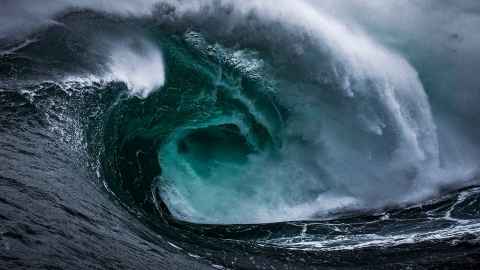World's oceans are hotter than ever
19 January 2022
Temperatures are rising in all oceans, reports Dr Kevin Trenberth, a climate-change expert affiliated with the Faculty of Science.

The world's oceans are hotter than ever, continuing their record-breaking
temperature streak for the third straight year.
The most recent report, authored by 23 researchers, including myself, at 14 institutes, was published this month in Advances in Atmospheric Sciences.
The ocean heat content is relentlessly increasing globally, and this is a primary indicator of human-induced climate change. We updated observations of the ocean throughout 2021, and revisited and reprocessed earlier data.
We also were able to attribute this to human activities mainly from increasing carbon dioxide and other greenhouse gases in the atmosphere.
The global mean surface temperature is the fifth or sixth warmest on record (depending on the data set) in part because of La Niña (cool conditions in the tropical Pacific), leading some to think global warming has abated. This is quite wrong.
The oceans continue to warm and take up about 93 per cent of the extra energy trapped by the increasing greenhouse gases. There is a lot more natural variability in surface temperatures from El Niño and weather events.
The oceans continue to take up heat during La Niña but bury it below the surface.
Relentless warming fuels storms, disrupts marine life, raises sea levels and melts ice shelves around Antarctica
In El Niño events, such as 2016, some heat comes out of the oceans and contributes to a mini global warming, so that 2016 remains the warmest on record for surface temperatures. But those wiggles are relatively small for the ocean.
Global warming is alive and well, unfortunately.
The natural variability on top of a warming ocean creates hot spots, sometimes called "marine heat waves", in various places that vary from year to year.
A major marine heat wave resides to the east of New Zealand, in part because of La Niña, which creates rainy conditions over Australia (earlier flooding in New South Wales and recent flooding in Queensland), but settled weather (anticyclones) east of New Zealand resulting in lower winds and sunny conditions, and warm and humid conditions over New Zealand.
Indeed, 2021 was the warmest ever for New Zealand.
Those hot spots have profound influences on marine life, from plankton to fish and marine mammals to birds. Other hot spots are responsible for more activity in the atmosphere, such as hurricanes.
In addition, all oceans are warming, although by largest amounts in the Atlantic and Southern Ocean. The latter affects sea ice and undermines ice shelves around Antarctica, resulting in calving off huge icebergs.
The global heating from increased greenhouse gases in the atmosphere also has important effects on land. Evaporation and drying on land raises temperatures, which further increases atmospheric demand for moisture, and increases risk of heat waves and wildfires, as has been seen in 2021, especially in western North America.
In addition, warmer oceans provide extra moisture through evaporative cooling of the oceans that can reduce hot spots, but the extra moisture in the atmosphere fuels storms, especially hurricanes, and the result can be prodigious rainfalls, such as in Hurricane Ida in the United States which caused widespread flooding all along the eastern regions from the Gulf of Mexico to Canada.
Several major flooding events occurred in New Zealand in Canterbury (May), Westport (July) and Northland (August). The storms may also become more intense and last longer. Bigger snowfalls can also occur in winter.

Ocean warming also leads to expansion and sea level rise, and combined with melting of land ice (glaciers, Greenland, etc), which puts more water into the oceans, global sea level has risen 101mm since 1993, when satellite observations began.
Sunny day flooding in coastal regions such as Miami and Norfolk, Virginia, is increasing, and storm surges in coastal regions are much worse.
Because ocean warming occurs from the top down, the ocean is becoming more stratified and stable, which affects all marine life and the ability of the oceans to take up carbon dioxide. The top 500m of the ocean has clearly been warming since 1980, from 500-1000m from about 1990, from 1000-1500m depth since 1998, and below 1500m depth since about 2005. The oceans will continue to warm, and sea level will continue to rise even after greenhouse gases are stabilised.
Finally, it is important to recognise the need to continue and build the observations in the ocean to obtain the knowledge of what is happening.
The Argo array of about 3900 profiling floats requires constant replenishment as an international endeavour involving 30 countries. New Zealand plays an especially important role in deploying these floats in the South Pacific and Southern Oceans.
Dr Trenberth is a Distinguished Scholar at the National Center for Atmospheric Research in Boulder, Colorado. He lives on the North Shore. This article is republished from the New Zealand Herald.
Media contact
Paul Panckhurst | media adviser
M: 022 032 8475
E: paul.panckhurst@auckland.ac.nz